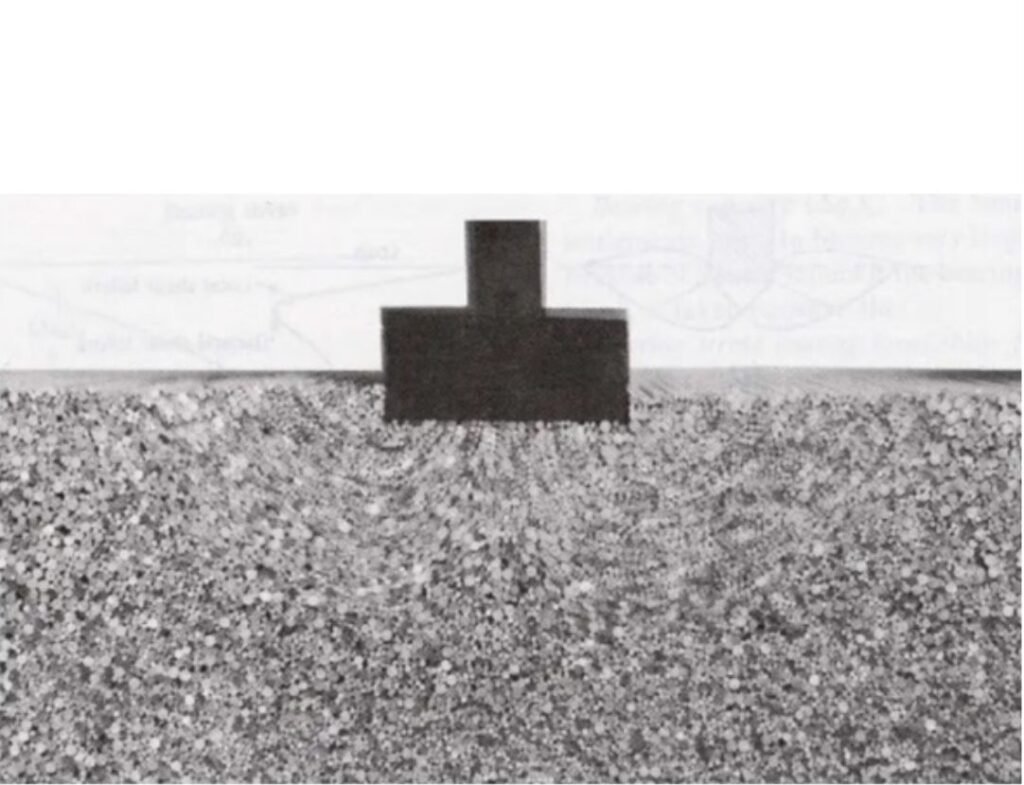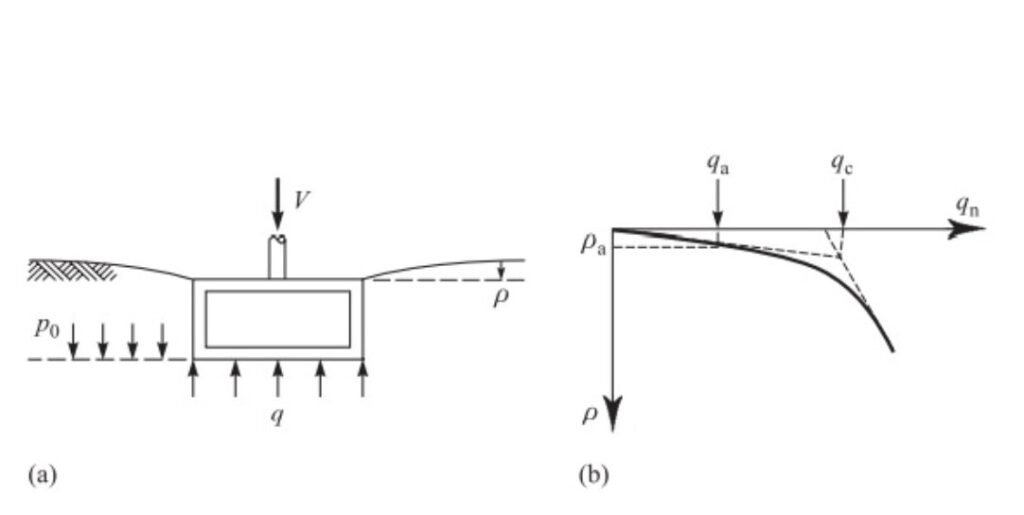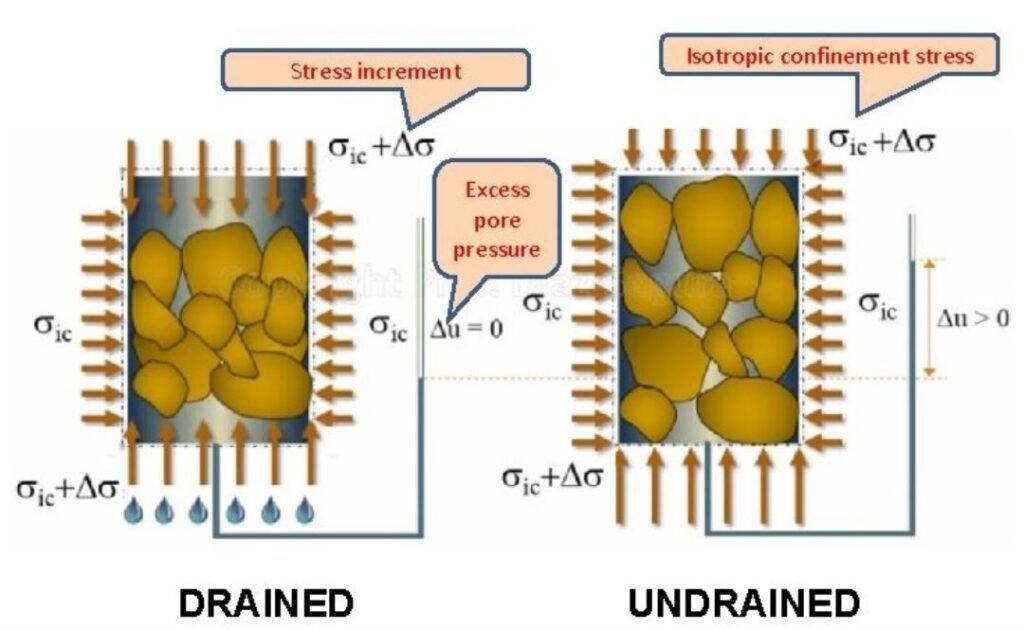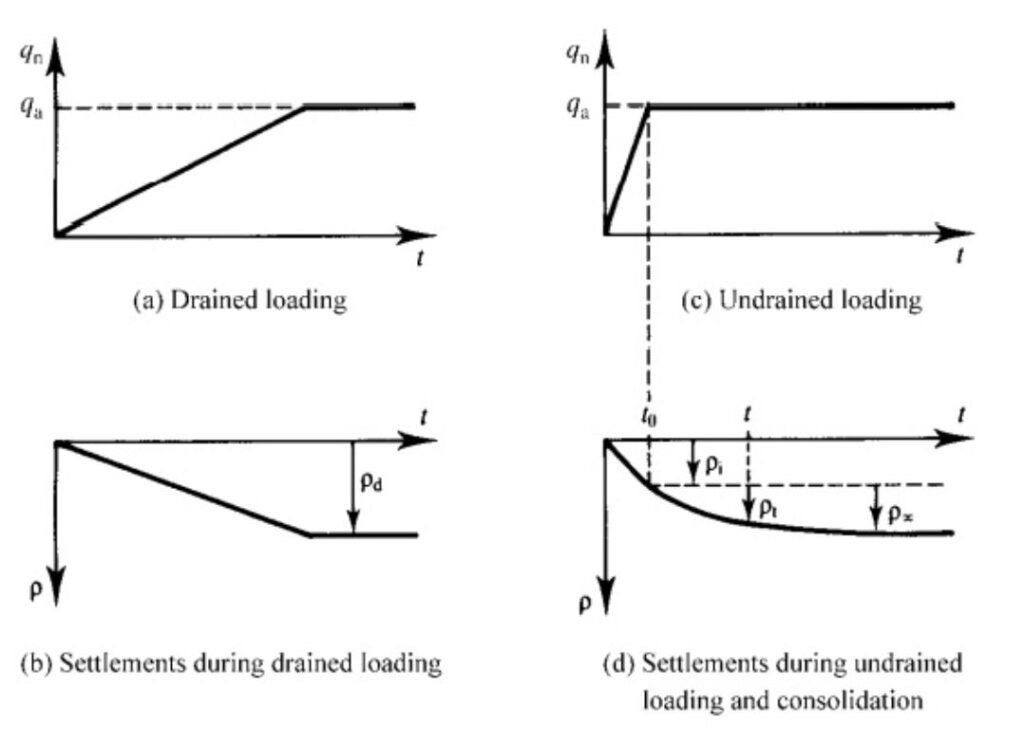
"If you can't explain it simply, you don't understand it well enough" (Albert Einstein)

geo
"If you can't explain it simply, you don't understand it well enough" (Albert Einstein)
Understanding shallow foundations behavior
Foundations are the connections between the superstructure and the ground, and although the behavior of these elements is complex, it is necessary to understand the basic principles that govern it.
Contents
Shallow foundations behavior
In the classic text by Lambe & Whitman (1969), a very illustrative photograph is included (which is reproduced in Figure 1), showing a laboratory scale model, in which the soil is represented by cylindrical rods, and they are loaded by a rigid footing.

Figure 1 Failure zones under a footing (Source: Lambe & Whitman, 1969).
As shown in the photograph, the rebars are displaced from the bottom of the footing and, at the same time, the shallower rebars, located at the sides of the foundation, are lifted.
This model is excellent for intuition of how failure can develop in granular soils. But, what is the behavior of shallow foundations in real soils?
Figure 2 may help to answer this question. It shows a simple shallow foundation with a bearing pressure q, a net bearing pressure qn and a settlement ρ. If the foundation is rigid (e.g., reinforced concrete), the settlement ,ρ will be uniform and the bearing pressure will vary along the foundation. If, on the other hand, the foundation is flexible (e.g., an earth embankment), the bearing pressure will be uniform, but the settlements will vary. Part (a) of Figure 2 illustrates the mean values of q and ρ for each case, while part (b) shows the relationship between the net bearing pressure qn and the settlement ρ. As seen in Figure 2 (b), as the bearing pressure increases, the settlements begin to accelerate, and at some point the foundation can be said to have failed due to the magnitude of these settlements.

Figure 2 Loading and settlement for a foundation (Source: Atkinson, 2007).
According to the above, it can be stated that foundations do not fail in the sense that they can no longer support a load, or that the load on them has reached a maximum or is beginning to decrease, but that they fail because an admissible limit settlement has been reached, above which the structure ceases to be functional.
It is obvious to mention that foundations should not be loaded with pressures close to their bearing capacity qc, since the settlements would be too large and the structure would probably be damaged (even if it does not collapse).
Thus, to limit settlements to an allowable value ρa it is necessary to reduce the bearing pressure to an allowable bearing pressure qa, as shown in Figure 2 (b). In practice, this is usually achieved by applying a load factor to the bearing capacity.
Drained and undrained loads effects
It has already been mentioned that, in general, foundations fail because certain levels of deformation are reached, after which the structure loses its functionality. This might sound strange to those who are used to think of the soil failing by shear, generating a sudden subsidence of the foundation. Although this case is feasible, in practice it is very rare and usually the problems associated with foundations are due to excessive deformations of the soil.
Now, how do loading conditions influence the behavior of the foundation? How does settlement occur under drained and undrained loading conditions?
The first important thing to take into account is that drained and undrained loading conditions depend on the loading rate, and these concepts are useful for fine, low permeability soils, such as loamy clays or coarse materials with clay particle contents higher than 25-30%, with high saturation levels. In the case of sands, the conditions will always be drained, given the high permeability of this type of material.

Figure 3 Stress conditions under drained and undrained loads (Source: https://slidetodoc.com/eat-212-soil-mechanics-chapter-4-shear-strength/, 2021).
Let us review Figure 4, taken from Atkinson (2007). Part (a) of that figure, shows the net bearing pressure of a foundation, increased to qa slowly, so that the load is drained. For this case, the settlements increase in parallel with the load up to the value ρd, as shown in part (b) of the figure. Part (c), illustrates the effect of the same load, but increased rapidly, so that in this case the load is undrained. This rapid loading produces an immediate, undrained settlement, called ρi, which is indicated in part (d) of the figure. The undrained load increases the pore pressure in the soil beneath the foundation, and dissipation of this excess pressure causes consolidation settlement to occur. The settlement at some time t after that of consolidation is ρt, and the final settlement occurring after a relatively long time is ρ∞.

Figure 4 Efect of load rateo on foundation settlements (Source: Atkinson, 2007).
As can be seen from the above analysis, it is important to consider the effect of load rate when designing a foundation. In general, in practice, the case illustrated by parts (c) and (d) of Figure 3 is usual. If conditions exist for soil consolidation to occur, long-term deformations may develop, up to ρ∞. Otherwise, deformations will be short-term, up to levels close to ρi.
Design considerations
As pointed out by Lambe & Whitman (1969), and according to the previous sections, the basic criterion for the design of a foundation is that the settlement should not exceed a certain admissible value.
In order to meet this basic criterion, all or some of the following values should be estimated (see Figures 2 and 3):
- The bearing capacity qc (to ensure that the foundation has an adequate margin of safety against collapse).
- The allowable bearing pressure qa and the drained settlement ρd or the immediate (undrained) settlement ρi, depending on the loading conditions prevailing in the project.
- The consolidation after loading, the final consolidation settlement ρ∞, and the variation of settlement ρt with time.
Finally, it is important to mention that not all structures support the same level of settlement. A fluid storage tank, for instance, will have a different deformation tolerance than, say, dynamic equipment, a wind turbine tower, or a steel frame structure. But this topic will be discussed in more detail in a future post.
References
- Atkinson, J. (2007) “The Mechanics of Soils and Foundations”. Second Edition. CRC Press – Taylor & Francis Group. Abingdon, UK.
- Das, B. (2009) “Shallow Foundations – Bearing Capacity and Settlement”. CRC Press – Taylor & Francis Group. Boca Raton, Florida, USA.
- Lambe, W. & Whitman, R. (1969) “Soil Mechanics”. John Wiley & Sons, Inc. New York, USA.